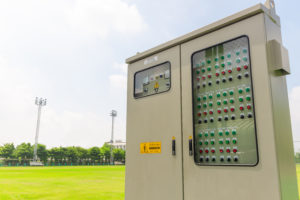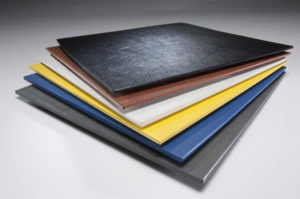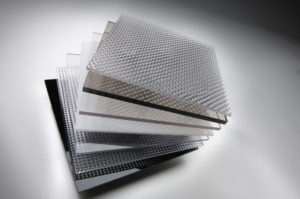
ABS vs Polycarbonate – here’s everything you need to know. First, both are both types of plastic material. Both offer a high level of impact resistance and are common in applications where durability is a must. More specifically, they are both popular in the production of hard-sided luggage, electrical enclosures, machine guards, and more.
However, there are also some key differences between these two types of plastics. If you’re in the market for a durable material and want to explore the options, here’s what you should know about both ABS and polycarbonate.
Are There Differences in the Composition of ABS Sheets vs Polycarbonate Sheets?
Polycarbonate is a thermoplastic polymer that contains carbonate chemical structures. It is transparent in nature, but can have color or patterns easily added to it. The chemical makeup of polycarbonate allows it to remain fairly temperature resistant. And it also resists most damage from impact or scratching, since it is able to absorb energy effectively without cracking or shattering.
On the other hand, ABS is a blend of three different types of plastics: acrylonitrile, butadiene, and styrene. Each one brings a different durability factor to the table. For instance, acrylonitrile offers superior hardness and resistance to chemicals. Butadiene is able to hold up well upon impact. And styrene is resistant to heat. Additionally, ABS is an opaque material. But it can be produced in a variety of colors to suit the specific needs of a project.
Are There Pros and Cons For Each?
Both of these plastics are known for impact resistance and durability. However, the extent to which they accomplish these goals varies depending on the situation. The most obvious visual difference between the two is that polycarbonate is naturally transparent, while ABS is opaque. This isn’t really a pro or con for either. It simply depends on the type of product or part that needs to be produced.
Polycarbonate is known for providing enough impact resistance to stand up to extreme conditions. It has even been integrated into things like armored vehicles and storm shelters designed to protect people during hurricanes or tornadoes. It’s also somewhat resistant to flames and high temperatures, so it’s well suited for environments where heating processes are used.
With ABS vs Polycarbonate, of the main benefits of ABS is its affordability. It tends to be easier to produce than a lot of other plastics on the market, and it can be easily customized to suit customers’ needs. In terms of appearance, it has a glossy finish on one side, and a haircell pattern on the other and can come in a wide array of colors and shades. Additionally, the material is fairly chemical resistant, so it’s able to be used in environments that require the use of chemicals for sterilization or other processes without breaking down or causing safety hazards.
Differences In How They Are Made
Polycarbonate is produced when bisphenol A (BPA) and phosgene COCl 2 are combined. This causes a condensation polymerization reaction that results in a strong yet clear material. Once the raw material is made, polycarbonate can be formed into sheets, tubes, or other shapes. It can also be cut to size, customized using tools like CNC machines, or exposed to additives to enhance color or texture.
On the other hand, ABS requires the polymerization of styrene and acrylonitrile while polybutadiene is also present. Since the nitrile groups used within this process are polar, they basically attract one another and bind the neighboring chains closely together. This tight bond is what causes ABS to be so much stronger than other types of plastic material like polystyrene.
Applications for ABS vs. Polycarbonate Material
As mentioned above, when it comes to ABS vs Polycarbonate, both materials are very popular for producing hard-sided luggage. However, each one has applications in other industries as well. Here are just a few of the most popular examples of how each one may be used in the real world.
Since polycarbonate is transparent, it’s especially popular in applications where clear visibility is a must. That feature, along with its impact resistant qualities, makes it perfect for protective “glass” systems. It can be used in windows, doors, auto glass, protective countertop systems at convenience stores and banks, and even military and armored vehicles. Polycarbonate is also a popular choice for everything from indoor and outdoor signs, and point-of-purchase displays, to machine guards and semiconductor components.
Since ABS is opaque, it’s better suited for applications or parts that require durability without clear visibility. This can include things like models and prototyping, displays, machine and electrical enclosures, guards and covers, storage cases and more. ABS is also an excellent choice for thermoforming a variety of parts including trays.
If you’re looking for a plastics distributor that offers both polycarbonate and ABS materials, Polymershapes can help. We offer a variety of quality materials from industry leading manufacturers. Our selection includes polycarbonate and ABS, along with other options like acrylic, HDPE, nylon, and PVC. Additionally, we also offer a variety of fabrication and customization options to ensure that your polycarbonate and ABS materials are made to your exact needs. As a nationwide brand, we offer unmatched quality and variety, but our local facilities are able to deliver fast order processing and personalized service. You can get in touch with our friendly and knowledgeable team so you can get started selecting the polycarbonate or ABS products that work best for your business and your specific application needs. Simply visit our branch locator online to start your next order.

